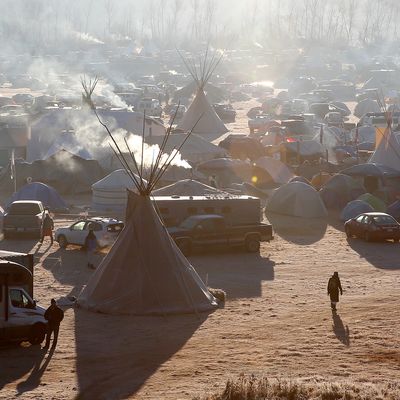
The Army Corps of Engineers has told the Standing Rock Sioux tribe that they have until December 5 to vacate the Army Corps–managed land that has become the site of one of three encampments supporting the tribe’s anti–Dakota Access Pipeline (DAPL) protest. After December 5, according to Army Corps Col. John W. Henderson, the land — which is north of the Cannonball River in Cannon Ball, North Dakota — will be closed to all public use and access, and anyone violating the ban may be prosecuted for trespassing. According to NPR, the tribal leader of the Standing Rock Sioux, Dave Archambault II, has vowed that the protesters will remain. “Although the news is saddening,” he said, “it is not all surprising given the last 500 years of mistreatment of our people.”
Henderson, in a statement, said their decision “is necessary to protect the general public from the violent confrontations between protestors and law enforcement officials that have occurred in this area, and to prevent death, illness, or serious injury to inhabitants of encampments due to the harsh North Dakota winter conditions.” The Corps also says they will designate a “free speech zone” south of the Cannonball River on Army Corps–owned land where the protests can continue, and where Henderson says there would be a clearer jurisdiction for first responders.
According to the Bismarck Tribune, protest organizer Dallas Goldtooth rejected Henderson’s assumption, claiming the designated zone would not accommodate the growing number of protesters, which now number about 7,000 people.
Several hundred people have created a self-sustaining community at the Oceti Sakowin camp, which was established in August and is the northernmost overflow encampment supporting the seven-month-long protest near Lake Oahe. Protesters are trying to block part of a $3.8 billion, 1,200-mile oil pipeline from being constructed nearby. The Standing Rock Sioux argue that the pipeline will desecrate some of their sacred sites and will endanger the tribe’s primary water source, the Missouri River, which the pipeline will eventually cross. Energy Transfer Partners, the company building the pipeline, denies those claims. The Standing Rock Sioux are also currently suing the Army Corps in federal court for not consulting the tribe before permitting the DAPL, but construction has been allowed to continue despite the ongoing legal battle.
The Army Corps had already promised that they would evict the encampment in October, and North Dakota governor Jack Dalrymple and U.S. senator John Hoeven both declared on Saturday that it was now up to the federal government to step in and help clear the protesters.
More than 500 people have been arrested for taking part in the ongoing protest, and there have been violent confrontations between protesters and state and local authorities, including an incident last weekend near the Oceti Sakowin camp in which a woman’s arm was severely injured, allegedly by a concussion grenade. During that same protest, law-enforcement personnel used water cannons to disperse demonstrators despite the near-freezing temperatures in the area. Members of some 200 First Nations tribes from across North America have joined the NoDAPL protest, which has become a cause célèbre for environmentalists over the past few months.
President-elect Donald Trump, who recently owned as much as $1 million of stock in the company building the pipeline, has vowed to support the DAPL project and speed up permits for other oil and gas pipelines once he takes office.






























